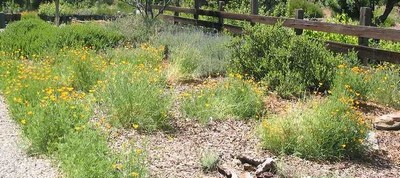It’s a method of landscaping that is wildlife friendly, promotes native plants and it can save you money on your water bill. In Texas, it is best known as wildscaping, and at the heart of the practice is resource conservation. With drought impacting every corner of the state, native plant wildscaping could be just what the biologists ordered to help you conserve water while maintaining some greenery in your yard.
With temperatures rising and water low, it’s a bad time to be a water-dependent plant in Texas. The latest U.S. Drought Monitor shows Texas gasping for water under a dark red thermal blanket of severe to exceptional drought intensity, the third worst dearth of rainfall seen by the state in recorded history. But there is something we can all do. Studies have found lawn care accounts for over 50 percent of a household’s water usage! Enter wildscaping.
Many Texas residents have already been asked to monitor and reduce their water usage, yet home and land owners may feel they have little control over water use when it comes to manicured lawns and upkeep of green spaces. They may have heard of alternative gardening as a way to cut costs and save water, but may not know where to turn for advice or resources.

Texas Parks and Wildlife Department (TPWD) can help. Wildlife biologist can demonstrate how to use native plants to conserve natural resources and provide habitat for beneficial native wildlife. The program, called “Texas Wildscapes,” has helped thousands of Texans realize the beauty and economy of using native plants in their home, office, and school landscapes.
The goal is to provide the information to people looking for ways to use native plant species to conserve resources at home or in their communities. In summary, wildscaping is a way to incorporate native plants into outdoor spaces to conserve water while preserving our Texas heritage. It’s a win-win-win.
If you are picturing nothing but rocks and cactus, think again. Wildscaping depends on native plants that require less water, but they can be every bit as showy as the exotic water-hogs many stores push. Wildscaping encompasses a specific type of plant and water conservation, but elsewhere the general landscaping technique of planting low water use gardens is commonly referred to as xeriscaping. Some even refer to the conservation gardening technique as water-wise landscaping or smartscaping, and it can go hand-in-hand with a rainwater harvesting system.
Call it what you wish, but the concept is a proven resource saver for water, native wildlife, time and money. According to Colorado State University, households and businesses can reduce their water intake and save 30 to 80 percent on their total annual water bill depending on the size and proper maintenance of a landscape design. Are wildscaping, native plants and wildlife management sounding pretty good yet?
Planning any landscaping project on your property or community area can be tricky, but several interest groups have put together a wealth of information online for beginners including videos and step by step guides. The best advice is to consider your values and start small. If you want to attract native honey bees and butterflies, consider planting sunflowers or gray goldenrods.
Attracting native wildlife with iendemic plants can also decrease the number of pests flying or crawling around your property. Texas critters who naturally avoid human domiciles tend to compete with others who become household pests, decreasing their prevalence in your home.
TPWD has a variety of resources available for creating native Wwldscapes that are drought-tolerant as well as attractive to the eye and to songbirds, butterflies and other wildlife that inhabit your yard. The recently updated Texas Wildscapes: Gardening for Wildlife contains photos, maps and landscaping diagrams and is available online or in bookstores across the state. Wildscaping is water-conscious way to promote native plants and provide more diverse wildlife habitat from the comfort of your home. And you will save money too!